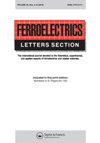Switching related activation field for polarization-reversal and for polarization-saturation in NaNO2-PVA thin composite films
IF 1.2
4区 物理与天体物理
Q4 PHYSICS, CONDENSED MATTER
引用次数: 3
Abstract
Abstract The remanant polarization in ferroelectric materials appear due to some lattice hindrances which do not allow the domains and their constituting unit cells to relax back to their previous orientations at zero value of sweeping field. This tendency appears in the form of capacitance due to shaking-up of the positive and negative charge centers of the structural unit cells in every domain leading to movement of charges throughout the system. It is this kind of movement and not the permanent dipole moment of the charges in the ferroelectric sample which becomes the cause of capacitance and hence helps the system to store energy from the applied electric field over there; the stored energy in the ferroelectric sample can be stripped off with the application of some minimum reverse field called activation field for polarization reversal. Landauer modeled average polarization current over the switching time and related rate of polarization switching with some minimum applied field below which polarization switching shall be too slow to attain saturation stage of polarization during the life time of the experiment designed for the purpose and accordingly the sample, in spite of being ferroelectric, shall not translate to ferroelectric hysteresis loop. In this paper ferroelectric switching analysis of equal wt% NaNO2-PVA composite fabricated at elevated temperature is carried.NaNO2-PVA复合薄膜中极化反转和极化饱和的开关相关激活场
摘要铁电材料中的剩余极化是由于某些晶格阻碍导致畴及其构成单元胞在扫场为零时不能松弛回原来的方向而产生的。这种趋势以电容的形式出现,这是由于结构单元胞的正电荷和负电荷中心在每个区域的震动导致整个系统中的电荷运动。正是这种运动,而不是铁电样品中电荷的永久偶极矩,成为电容的原因,从而帮助系统从外加电场中储存能量;铁电样品中储存的能量可以通过施加最小的反场(称为极化反转激活场)来剥离。Landauer用最小的外加场来模拟随开关时间的平均极化电流和相关的极化开关速率,在这个最小的外加场下,在为此目的设计的实验寿命期间,极化开关将太慢而无法达到极化的饱和阶段,因此,样品虽然是铁电的,但不会转化为铁电磁滞回线。本文对高温制备的等wt% NaNO2-PVA复合材料进行了铁电开关分析。
本文章由计算机程序翻译,如有差异,请以英文原文为准。
求助全文
约1分钟内获得全文
求助全文
来源期刊

Ferroelectrics Letters Section
物理-物理:凝聚态物理
CiteScore
1.10
自引率
0.00%
发文量
1
审稿时长
4.8 months
期刊介绍:
Ferroelectrics Letters is a separately published section of the international journal Ferroelectrics. Both sections publish theoretical, experimental and applied papers on ferroelectrics and related materials, including ferroelastics, ferroelectric ferromagnetics, electrooptics, piezoelectrics, pyroelectrics, nonlinear dielectrics, polymers and liquid crystals.
Ferroelectrics Letters permits the rapid publication of important, quality, short original papers on the theory, synthesis, properties and applications of ferroelectrics and related materials.
 求助内容:
求助内容: 应助结果提醒方式:
应助结果提醒方式:


